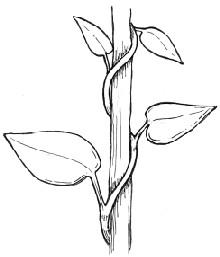Now let’s get back to the garden, and look at some of
the ways familiar garden plants maximize their exposure to, and absorption of, sunlight.Vining plants reach for the sky using various adaptations:
- Pole bean vines twine around a support.
- Clematis wrap their leaf stalks around a trellis.
- The terminal leaves on a sweet pea’s compound leaves
are modified into tendrils that can grasp a support.
- Virginia creeper has little suction cup-like appendages
that can stick to almost anything.
- English ivy forms aerial roots that penetrate
rough surfaces.
Some plants, such as sunflowers, simply grow tall very
quickly, outpacing the competition. Others, like strawberries, send out horizontal
runners, forming a new plant away from the shade and competition of the parent plant.
In Week 1 we discussed variations in leaf shape. Though
it’s impossible to know for sure what environmental conditions led to the evolution
of a particular characteristic, it is possible that the various leaf shapes are in part
adaptations to maximize the plant’s ability to capture light. Let's speculate on how
different leaf shapes might increase the plant’s exposure to sunlight:
- Roses and locust trees have leaves composed of small
leaflets, allowing sunlight to filter down to lower leaves.
- Oaks and maples have lobed or notched leaves, letting some
light reach to leaves deep within the canopy.
- Coleus carry their leaves in opposite pairs so that, when
viewed from above, most of the leaf surfaces are visible, and therefore will receive
sunlight.
- Canada lilies have leaves in whorls, allowing all the
leaves in the whorl their share of sunlight.
Why is there such variation—why didn’t all
plants develop notched leaves, for example, to maximize the collection of sunlight? If you
picture evolution as a huge family tree, you can begin to imagine the first, second, and
subsequent generations. As you progress down the tree, the number of family members
increases. So it’s easy to see how different plants subjected to the same stresses
might have adapted in different ways. Or, to put it another way, different genetic
mutations occurred. Perhaps mutations in the forebears of maple trees yielded a tree with
notched leaves, and this tree was more efficient at capturing sunlight than its siblings.
A different mutation (or successive mutations) might have yielded different
results—perhaps a tree with rose-like leaflets.
|
|
Vines
Methods of Climbing



|
|
|